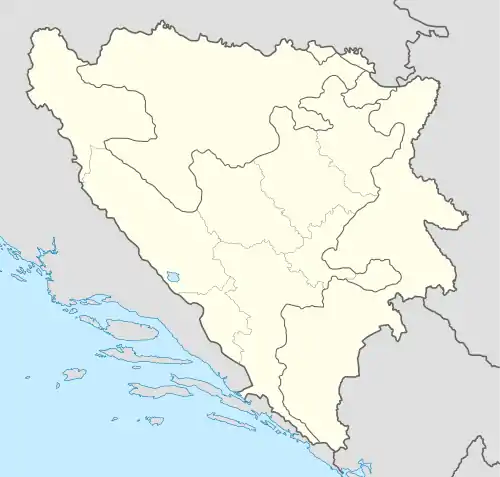Oplećani | |
|---|---|
Village | |
 Oplećani | |
| Coordinates: 43°43′N 17°17′E / 43.717°N 17.283°E | |
| Country | Bosnia and Herzegovina |
| Entity | Federation of Bosnia and Herzegovina |
| Canton | Canton 10 |
| Municipality | Tomislavgrad |
| Area | |
| • Total | 16.20 km2 (6.25 sq mi) |
| Population (2013) | |
| • Total | 376 |
| • Density | 23/km2 (60/sq mi) |
| Time zone | UTC+1 (CET) |
| • Summer (DST) | UTC+2 (CEST) |
Oplećani or Oplećane is a village in the Municipality of Tomislavgrad in Canton 10 of the Federation of Bosnia and Herzegovina, an entity of Bosnia and Herzegovina.
Name
Originally, the village was called Oplećane.[1]
History
Franciscan Petar Bakula wrote two schematisms, one for the Franciscan Province of Herzegovina in 1867, and the other for the Apostolic Vicariate of Herzegovina in 1873.[2] According to these two schematisms, in 1867, Oplećani had 25 Catholics, and in 1873, their number rose to 46.[3]
Northeast of the village there's an Illyrian fortress,[4] while in the Catholic and the Eastern Orthodox cemeteries there are 24 stećci, medieval tombstones.[5]
Population
| Ethnic group | Population 2013[6] |
Population 1991[7] |
Population 1981[8] |
Population 1971[9] |
Population 1961[10] |
|---|---|---|---|---|---|
| Bosniaks/Muslims | 308 (81.91%) | 306 (72.17%) | 306 (71.50%) | 299 (71.87%) | 290 (66.82%) |
| Croats | 67 (17.82%) | 76 (17.92%) | 73 (17.06%) | 66 (15.87%) | 65 (14.98%) |
| Serbs | 0 | 36 (8.49%) | 43 (10.05%) | 50 (12.02%) | 79 (18.20%) |
| Others or unknown | 1 (0.27%) | 6 (1.42%) | 6 (1.40%) | 1 (0.24%) | 0 |
| Total | 376 | 424 | 428 | 416 | 434 |
Footnotes
- ↑ Kovačević 2000, pp. 501, 508.
- ↑ Knezović 2000, pp. 197–198.
- ↑ Knezović 2000, p. 203.
- ↑ Šarić 2000, p. 617.
- ↑ Milić 2000, p. 622.
- ↑ Ethnicity/National Affiliation, Religion and Mother Tongue 2019, pp. 532–533.
- ↑ Nacionalni sastav stanovništva 1993.
- ↑ Nacionalni sastav stanovništva FNR Jugoslavije 1994a.
- ↑ Nacionalni sastav stanovništva FNR Jugoslavije 1994b.
- ↑ Nacionalni sastav stanovništva FNR Jugoslavije 1994c.
Bibliography
- Ethnicity/National Affiliation, Religion and Mother Tongue (PDF). Sarajevo: Agency for Statistics of Bosnia and Herzegovina. 2019.
- Knezović, Pavao (2000). "Duvanjski kraj u franjevačkim šematizmima" [The region of Duvno in the Franciscan schematisms]. In Krišto, Jure (ed.). Duvanjski zbornik [The collection of papers of Duvno] (in Croatian). Zagreb-Tomislavgrad: Hrvatski institut za povijest–Naša ognjišta–Zajednica Duvnjaka Tomislavgrad. ISBN 9536324253.
- Kovačević, Marko (2000). "Duvanjski govor i njegove posebnosti" [The speech of Duvno and its peculiarities]. In Krišto, Jure (ed.). Duvanjski zbornik [The collection of papers of Duvno] (in Croatian). Zagreb-Tomislavgrad: Hrvatski institut za povijest–Naša ognjišta–Zajednica Duvnjaka Tomislavgrad. ISBN 9536324253.
- Milić, Angelika (2000). "Popis nekropola duvanjskog područja" [The list of necropolis of the territory of Duvno]. In Krišto, Jure (ed.). Duvanjski zbornik [The collection of papers of Duvno] (in Croatian). Zagreb-Tomislavgrad: Hrvatski institut za povijest–Naša ognjišta–Zajednica Duvnjaka Tomislavgrad. ISBN 9536324253.
- Nacionalni sastav stanovništva [The national composition of the population] (PDF) (in Serbo-Croatian). Sarajevo: Državni zavod za statistiku Republike Bosne i Hercegovine. 1994.
- Nacionalni sastav stanovništva FNR Jugoslavije [The national composition of the population of the FNR Yugoslavia] (PDF) (in Serbo-Croatian). Vol. 1. Belgrade: Savezni zavod za statistiku. 1994.
- Nacionalni sastav stanovništva FNR Jugoslavije [The national composition of the population of the FNR Yugoslavia] (PDF) (in Serbo-Croatian). Vol. 2. Belgrade: Savezni zavod za statistiku. 1994.
- Nacionalni sastav stanovništva FNR Jugoslavije [The national composition of the population of the FNR Yugoslavia] (PDF) (in Serbo-Croatian). Vol. 3. Belgrade: Savezni zavod za statistiku. 1994.
- Šarić, Ivan (2000). "Arheološka topografija duvanjskog kraja" [The archeological topograhy of the region of Duvno]. In Krišto, Jure (ed.). Duvanjski zbornik [The collection of papers of Duvno] (in Croatian). Zagreb-Tomislavgrad: Hrvatski institut za povijest–Naša ognjišta–Zajednica Duvnjaka Tomislavgrad. ISBN 9536324253.
This article is issued from Wikipedia. The text is licensed under Creative Commons - Attribution - Sharealike. Additional terms may apply for the media files.